This series of articles features the 13 unique individuals who have led NASA’s Johnson Space Center (JSC) in Houston during the past 60 years and continue to lead us into the future of human space exploration. The first two installments described the Project Management Building and the center’s first four directors through 1986. This article, covering the period from 1986 to 1993, focuses on JSC’s fifth director Aaron Cohen, who led the center in the space shuttle’s safe return to flight after the Challenger tragedy, through redesigns of the space station, and significant construction at JSC to prepare for the new program. In addition to making high-level decisions to maintain America’s leadership in human spaceflight, JSC’s center directors’ many varied activities also include greeting astronauts after their return from space, dedicating new facilities, and meeting with local politicians, world leaders, and celebrities. For more information about the directors who led the center, please visit Johnson Space Center Directors | NASA.
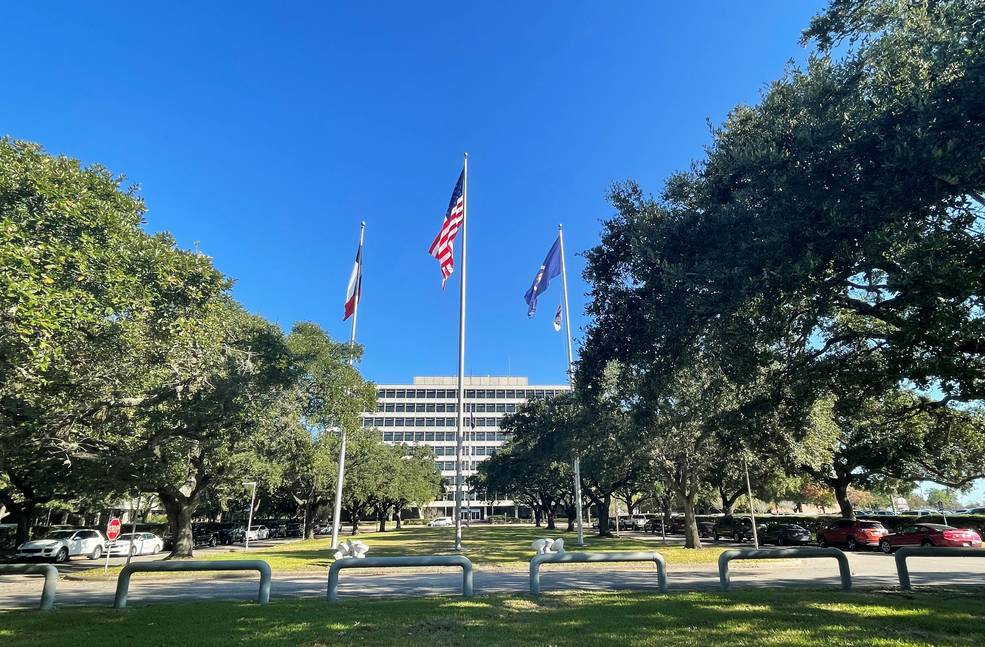
The Project Management Building, known today as Building 1, with its four flagpoles, at NASA’s Johnson Space Center in Houston, in November 2021.
Aaron Cohen (October 1986 to August 1993)
Aaron Cohen joined JSC, then known as the Manned Spacecraft Center, in 1962 as a structural and materials engineer in the spacecraft research division working on the Apollo spacecraft. He assumed progressively more responsible positions in the Apollo Program Spacecraft Office, becoming manager of the command and service modules in 1970. Two years later, he joined the newly-formed Space Shuttle Program as manager of the Orbiter Project Office, serving in that position until 1982 when he became director of engineering and development. After one year in that role, he was named director of research and engineering before being named JSC’s fifth director in October 1986, succeeding Jesse W. Moore.
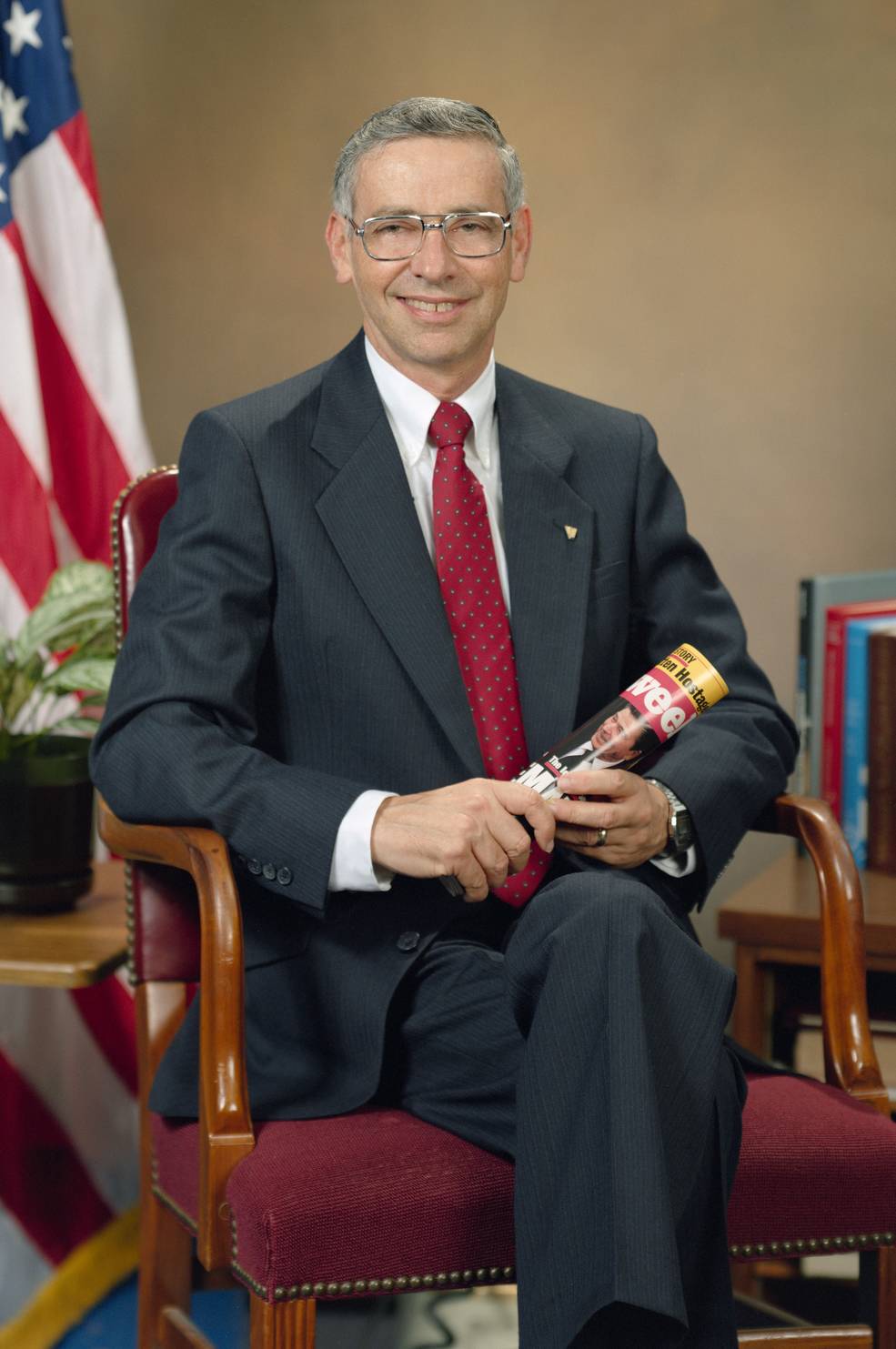
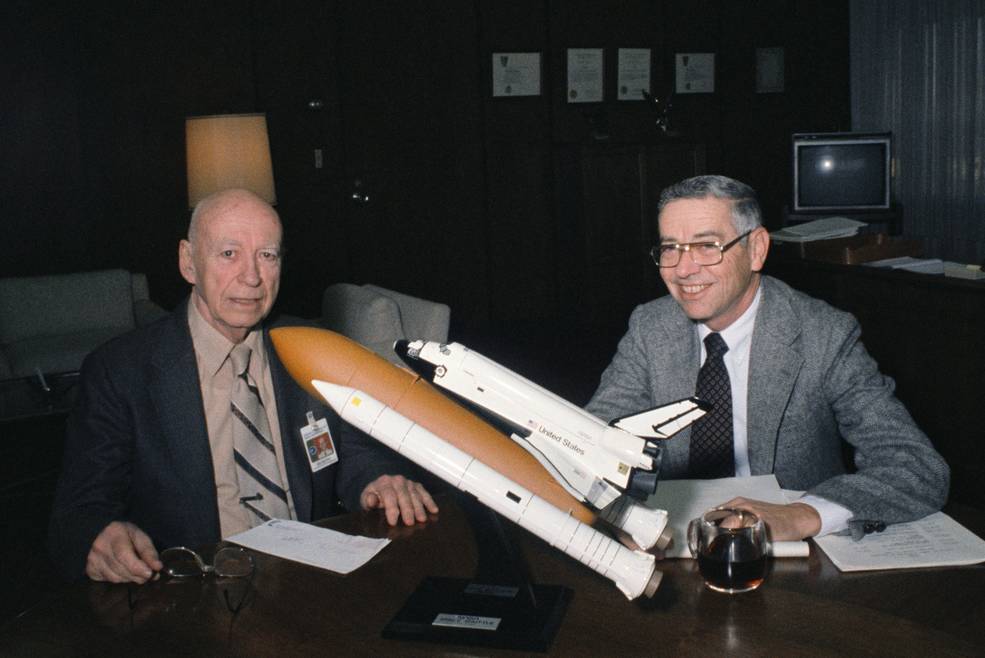
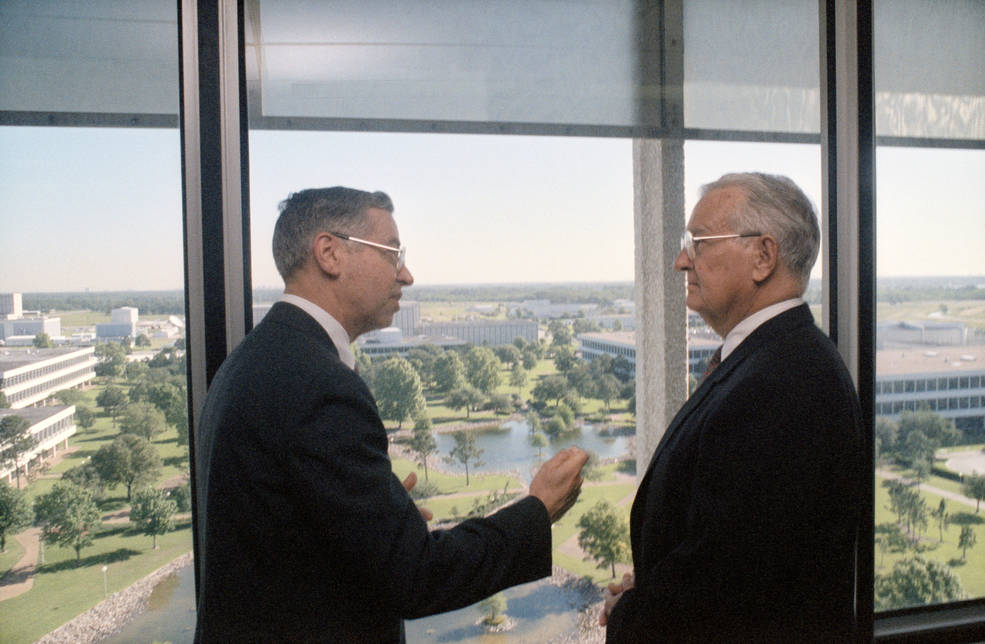
Left: Official portrait of Aaron Cohen, fifth director of NASA’s Johnson Space Center (JSC) in Houston. Middle: Robert R. Gilruth, the first director (1961-1972) of JSC, then known as the Manned Spacecraft Center, visits with JSC Director Aaron Cohen in January 1988. Right: Cohen, left, with Texas Governor William P. Clements during his May 1988 visit to JSC.
Cohen took over the helm at JSC nine months after the January 1986 Challenger accident. In addition to safely returning the space shuttle to flight, Cohen’s other major task involved preparing the center for the space station, a program President Ronald W. Reagan directed in 1984 that still faced significant development challenges. To address these and other pressing issues, in his first few months in office Cohen instituted several changes in JSC’s top management. To help him manage the day-to-day operations of the center, Cohen named Skylab and Shuttle astronaut Paul J. Weitz as his deputy, replacing Robert C. Goetz. He named Henry O. Pohl director of engineering, replacing Thomas L. Moser who became director of the Space Station Program Office, at the time managed at NASA Headquarters in Washington, D.C. Cohen named JSC Associate Director Carolyn L. Huntoon as director of Space and Life Sciences. She succeeded him as center director in 1994.
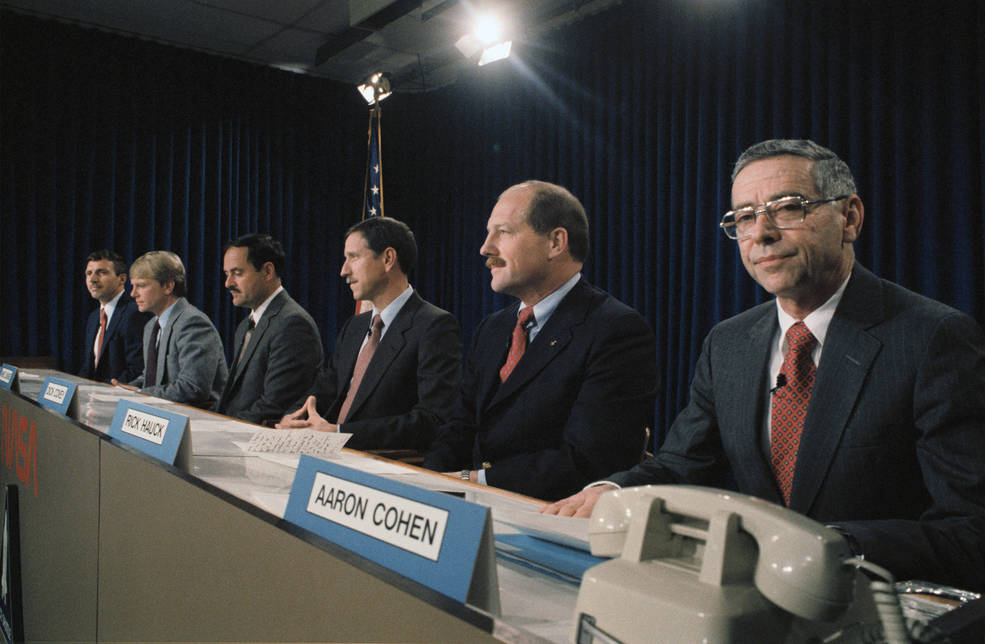
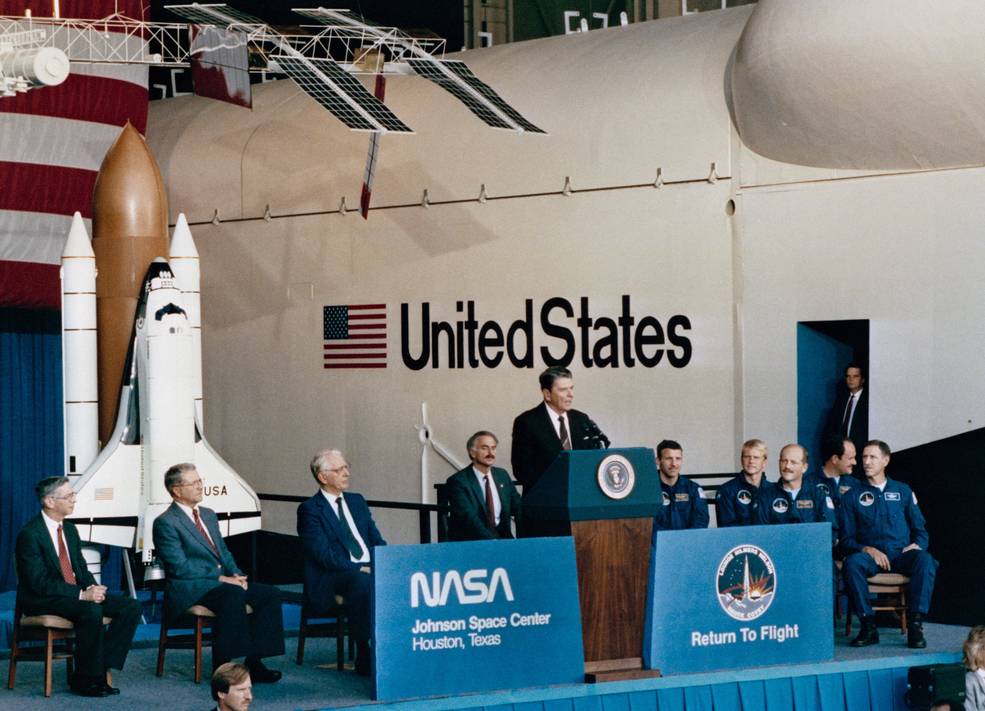
Left: Director of NASA’s Johnson Space Center (JSC) in Houston Aaron Cohen, right, during a January 1987 press conference to introduce the STS-26 crew. Right: Cohen, left, listens to President Ronald W. Reagan during his visit to JSC in September 1988, just a few days before the STS-26 crew, at right, departed for their launch to return
the shuttle to flight.
As part of the shuttle’s return to flight activities, Cohen introduced the five-member STS-26 crew during a press conference in January 1987. In September 1988, a few days before they launched into space, President Reagan visited JSC, where he met with the crew and with Cohen, and reaffirmed his support for the nation’s space program. On Sep. 29, Discovery’s STS-26 crew safely returned the space shuttle to flight. Over the next five years, Cohen oversaw 30 more shuttle missions, including the addition of Challenger’s replacement Endeavour to the fleet in 1991. Highlights of those missions included the first interplanetary probes launched from the shuttle to study Venus, Jupiter, and the Sun’s polar regions, deployment of two of NASA’s Great Observatories, the Hubble Space Telescope and the Gamma Ray Observatory, eight Spacelab-class science missions, seven missions for the Department of Defense, the first three-person spacewalk to repair the Intelsat satellite, and demonstrations of technologies and techniques needed for space station construction and operations. To support future space shuttle and space station missions, during this time NASA selected 62 new astronauts, including five from Canada, Japan, France, and Italy, in three classes in 1987, 1990, and 1992. The selected astronauts included women and minorities. While the space shuttle completed these remarkable missions, Cohen also focused on the development of the space station.
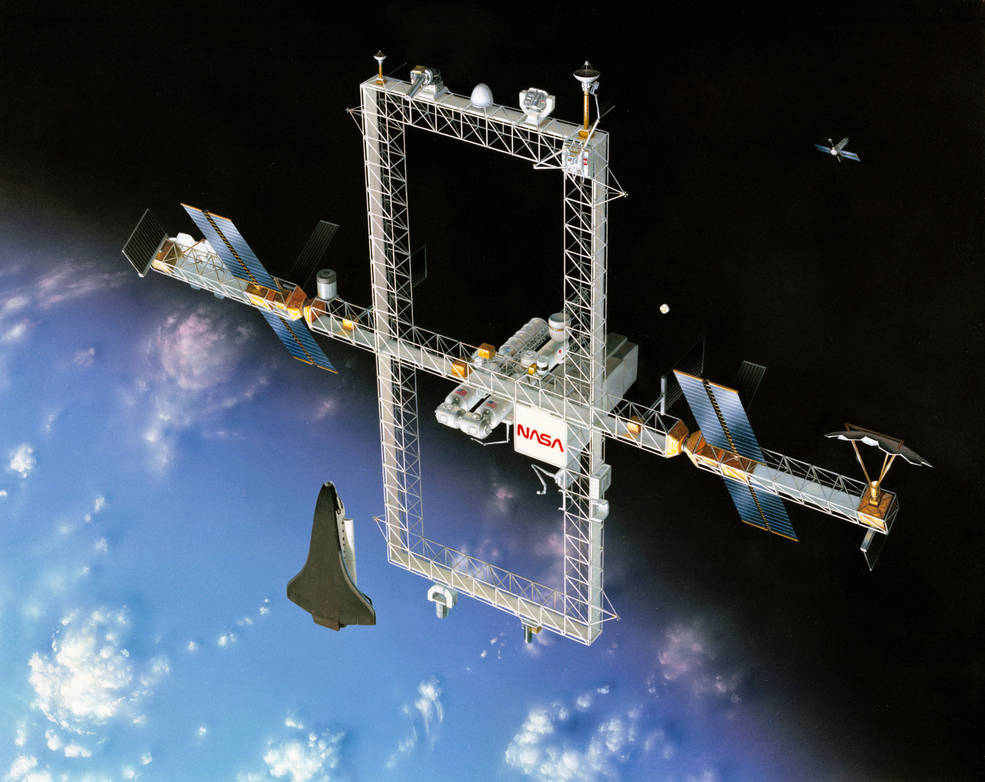
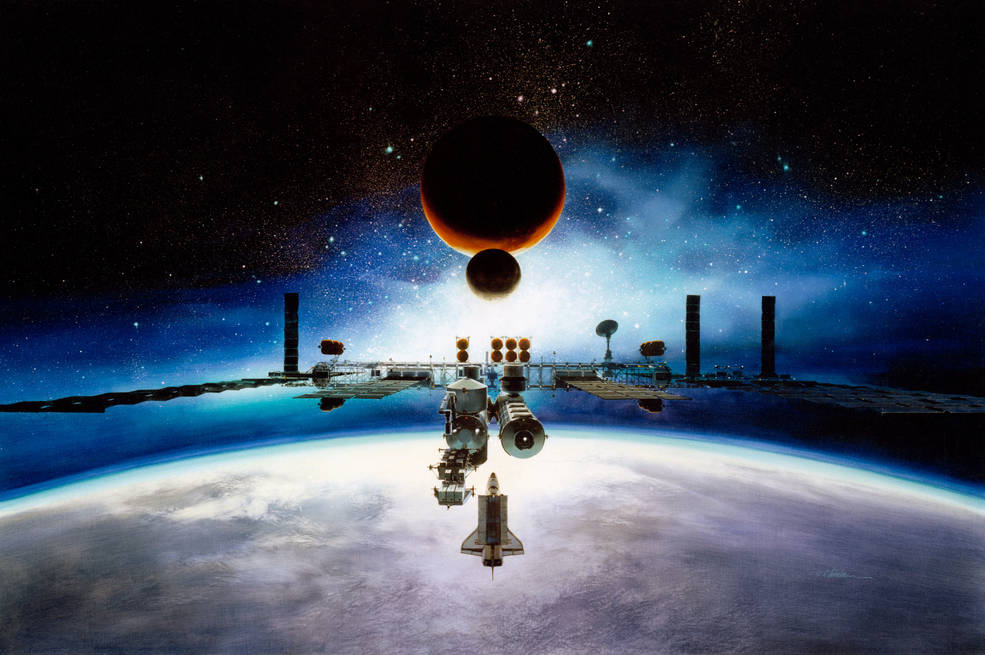
Left: An illustration from 1987 of the proposed dual keel space station configuration. Right: An illustration of space station Freedom from September 1991.
The planned space station evolved significantly during Cohen’s time as center director. In April 1987, President Reagan approved a new space station configuration for the orbiting platform, consisting initially of a single truss and pressurized elements from Canada, Japan, and the European Space Agency ESA. The station would then be expanded to a larger dual-keel configuration, with a permanent U.S. presence expected by 1996. In July 1988, President Reagan formally named the space station Freedom and two months later, the United States and its international partners signed Inter-Governmental Agreements to formalize their roles and responsibilities in the program. With the station’s projected costs escalating, managers downsized its capabilities in 1991 and 1992, with Freedom surviving congressional cancellation by just one vote in June 1993. In September 1993, the United States and Russia agreed to merge Freedom with Russia’s planned Mir-2 complex to form the International Space Station, with JSC established as the center to manage the program. To gain experience working together in space, the two nations also established the Shuttle-Mir Program as a precursor, in which space shuttles docked with the Mir space station and American astronauts conducted experiments during long-duration missions aboard the Russian facility.
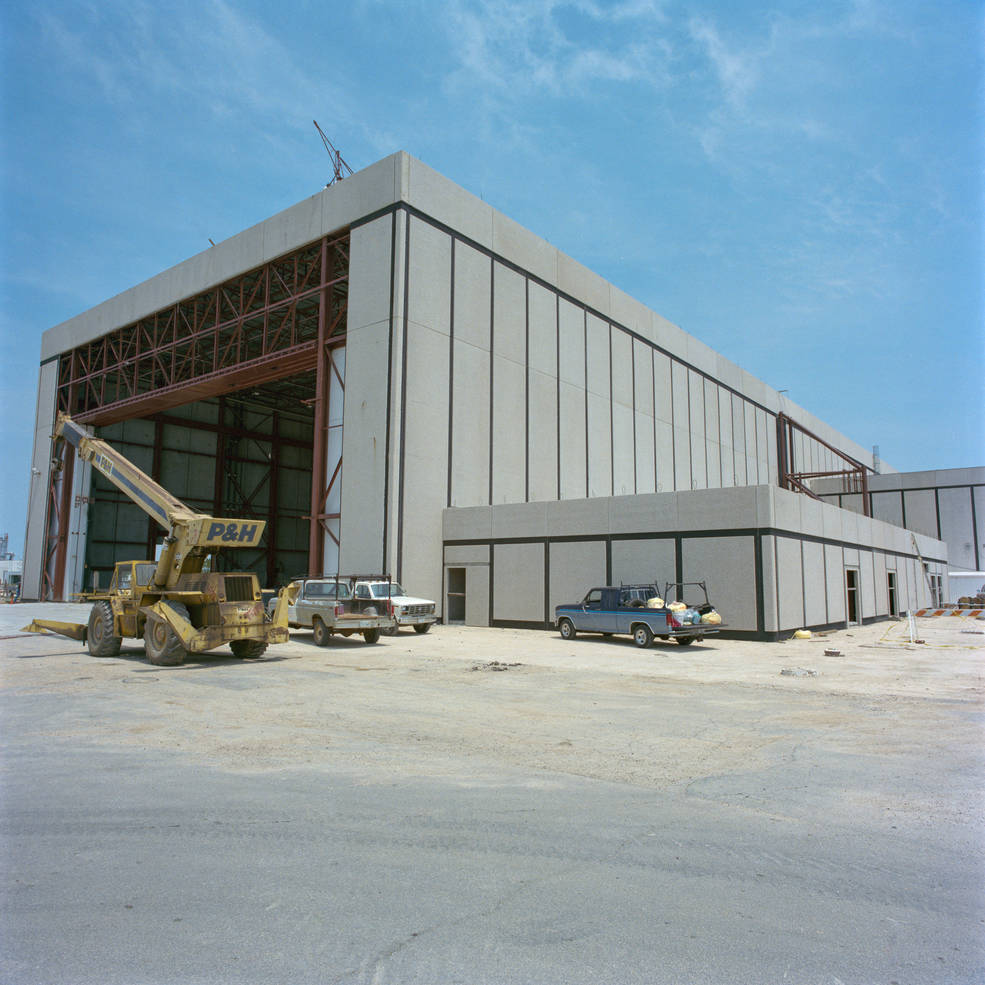
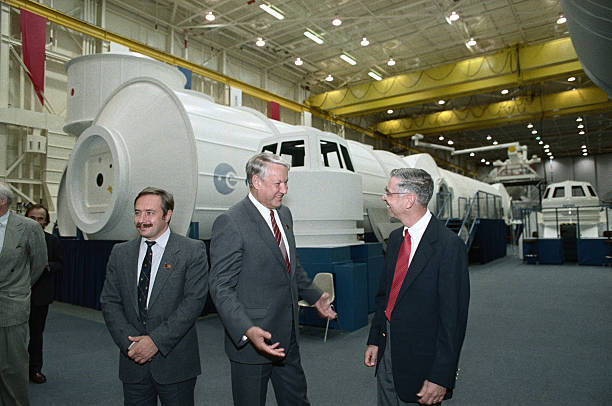
Left: Construction of Building 9B, space station the mockup facility, nearing completion in April 1988. Right: In Building 9B, Director of NASA’s Johnson Space Center in Houston Aaron Cohen tours members of Russia’s Parliament and future President of the Russian Federation Boris N. Yeltsin through the mockups of space station Freedom
modules in September 1989.
Part of the largest construction effort at JSC since the 1960s, several major projects during Cohen’s tenure prepared the center to handle the additional training and operations requirements of the space station era. Construction of a 27,000-square-foot addition to the Systems Integration and Mockup Laboratory, designated as Building 9B, or the Space Station Mockup and Trainer Facility, began in April 1987. Workers moved mockups of space station Freedom modules into the facility in September 1988, and Cohen led the official ribbon-cutting ceremony two months later. Boris N. Yeltsin, then a member of Russia’s Parliament and future President of the Russian Federation, visited the space station Freedom mockups, hosted by Cohen, as well as Mission Control on Sep. 16, 1989. His much-publicized visit to a local supermarket overshadowed his brief tour of JSC. A high-bay and a three-story laboratory area to support space station robotics were also added to Building 9 in 1991.
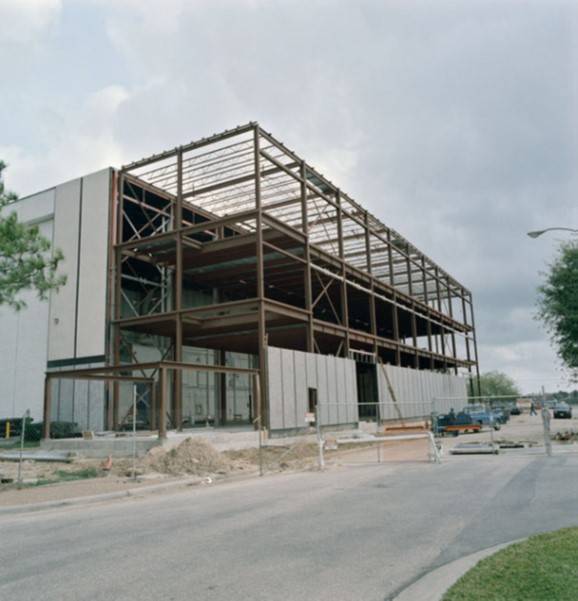

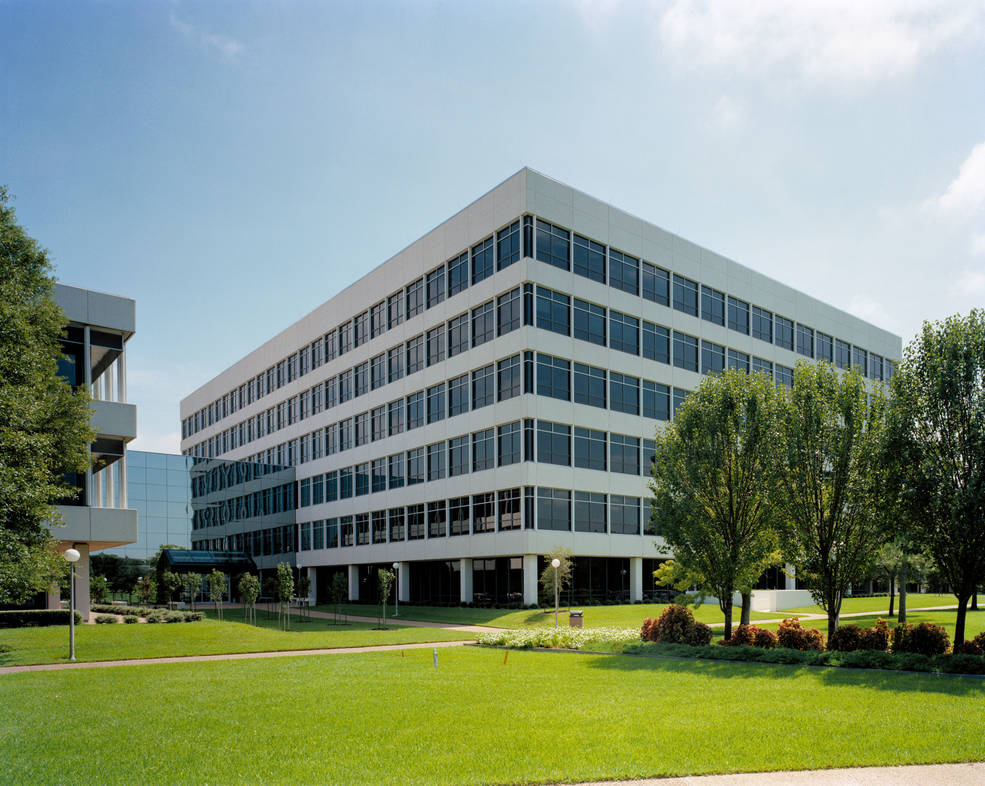
Left: The Space Station Training Facility addition to Building 5 under construction November 1990. Middle: The Space Station Control Center addition to Building 30 nearly complete in August 1991. Right: Building 4-South shortly after completion in September 1993.
The Mission Simulation and Training Facility in Building 5 required some rearranging and expansion to accommodate the new space station simulators. Workers removed the large Skylab trainers in November 1989, placing them in temporary storage until they could be relocated to the new visitors center then under development. Construction of the new three-story Space Station Training Facility (SSTF) addition to Building 5 began in April 1990 and finished in July 1991. To prepare for space station’s continuous operations, the Mission Control Center in Building 30 received the five-story Space Station Control Center (SSCC) wing, begun in April 1990 and completed in November 1991. Cohen led the joint dedication ceremony for the SSTF and SSCC in February 1992. Construction began in July 1991 of the new six-story Building 4-South to provide office space for an expanded astronaut corps and for mission operations and space station program personnel. Occupancy started in early 1993.
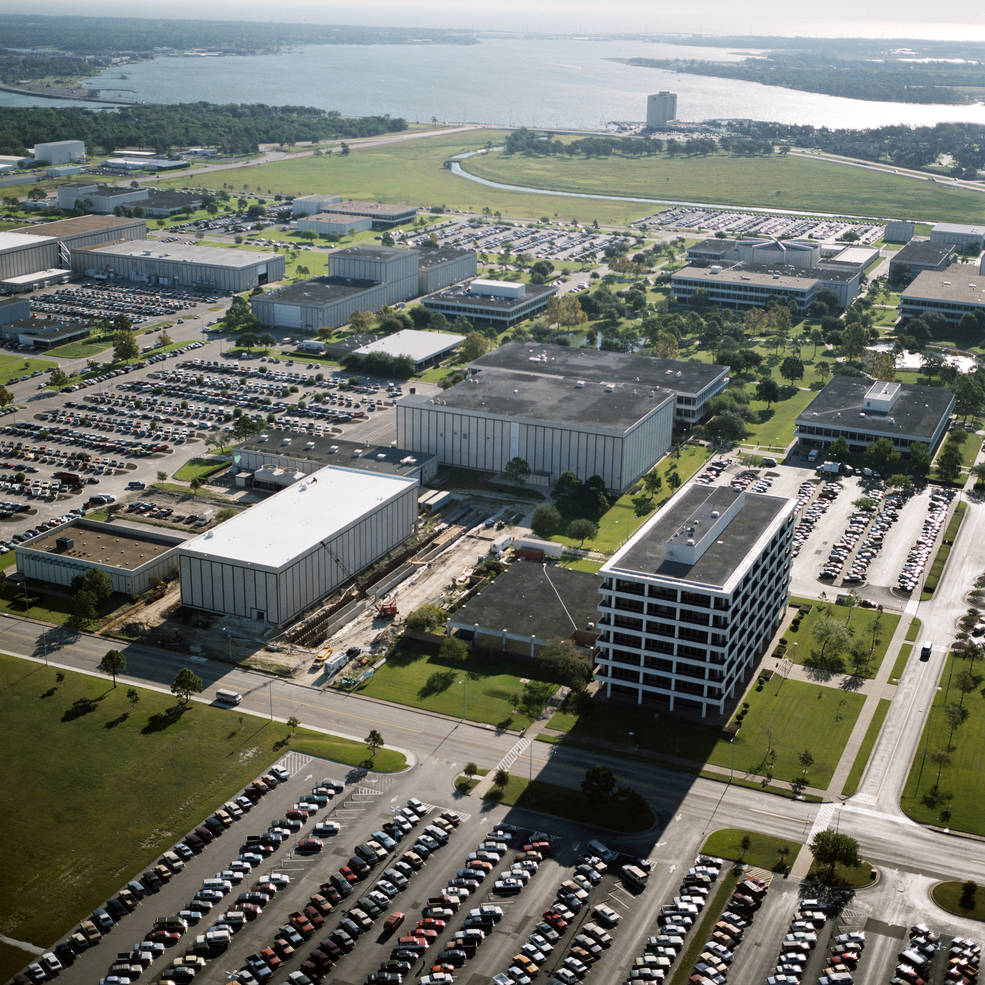
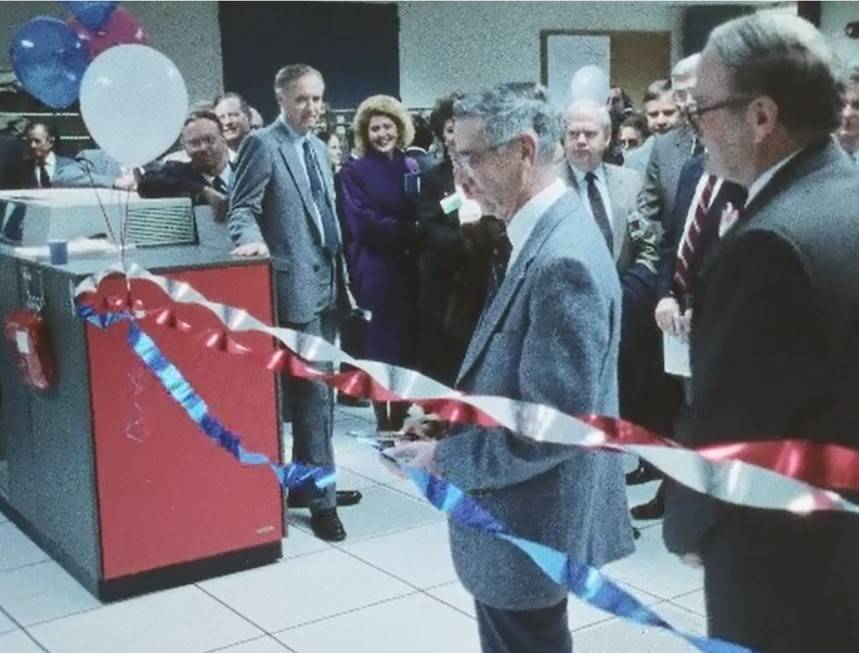
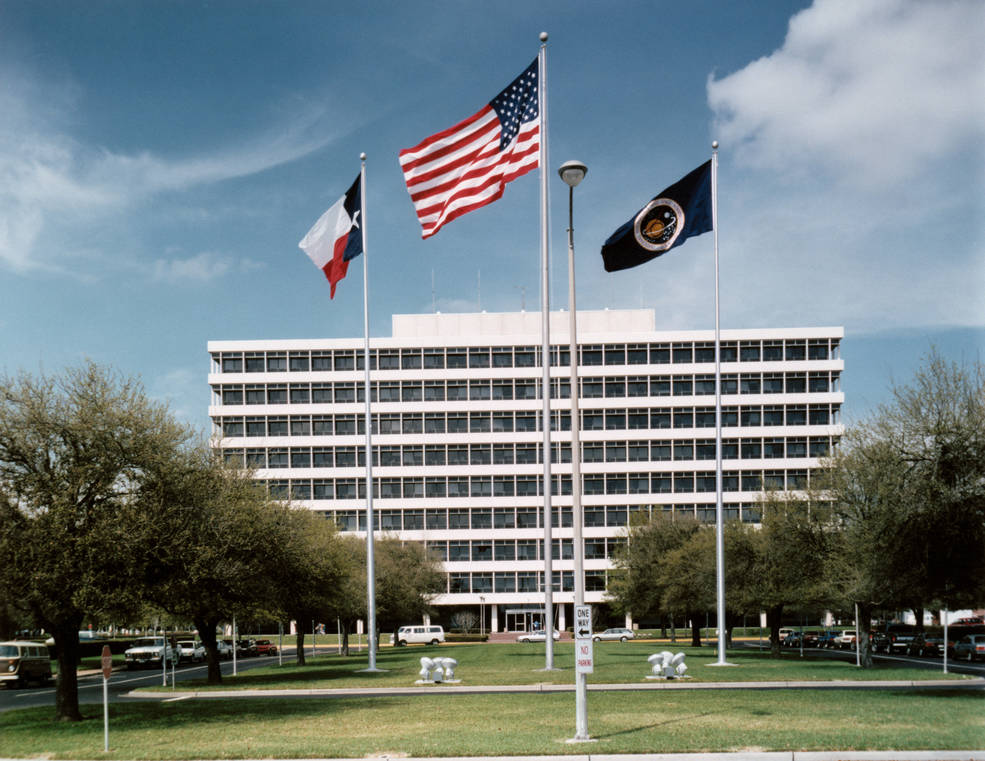
Left: Aerial view of NASA’s Johnson Space Center (JSC), showing Building 46, the Central Computing Facility, left of center, nearing completion in late 1988. Middle: JSC Director Aaron Cohen cutting the ribbon to inaugurate the Central Computing Facility in Building 46 in February 1989. Right: New flagpoles installed outside Building 1 in March 1989.
In addition to the new facilities to support the space station program, the center saw other additions and improvements during Cohen’s tenure as director. Citing the health risks of smoking, in April 1987 Cohen instituted a new strict on-site smoking policy and made available smoking cessation workshops for employees, leading JSC to become a non-smoking facility by Jan. 1, 1991. In July 1989, in front of Building 1, the original 88-foot American flagpole was relocated and flanked by two new 77-foot poles flying the Texas flag and the NASA banner. Construction of the Central Computing Facility in Building 46 to provide JSC with state of art computing capability and security began in November 1987, and Cohen officiated at the ribbon-cutting ceremony on Feb. 9, 1989. To meet increased cooling needs at the center, construction began on an auxiliary chiller facility, Building 28, in June 1989. The facility went into service in March 1991.
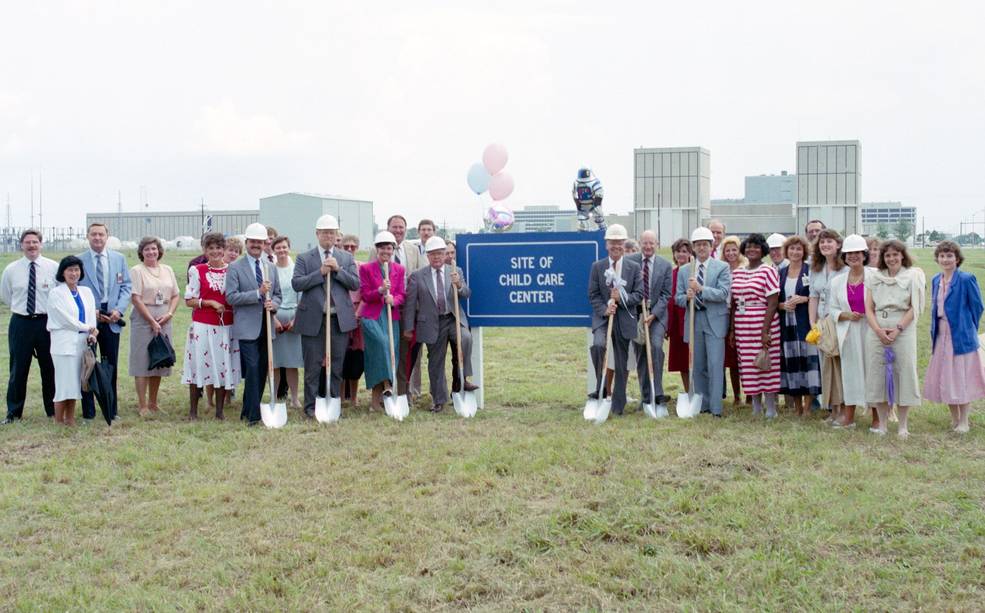

Left: Director of NASA’s Johnson Space Center (JSC) in Houston Aaron Cohen, to the right of the sign, during the groundbreaking ceremony for the Child Care Center in July 1989. Right: The JSC Child Care Center shortly before its opening in April 1990.
Two construction projects benefited JSC employees and their families. On July 7, 1989, Cohen led the groundbreaking for JSC’s Child Care Center, and he and his wife Ruth cut the ribbon at the facility’s grand opening on April 29, 1990. The facility welcomed employees’ children the next day, with a capacity to accommodate 64 kids. Due to increasing demand, a larger Child Care Center replaced this building in 2000 and was named after Cohen in 2011. Construction began in October 1990 on a new gymnasium at the Gilruth recreation center, with the new gym, primarily designed for basketball and volleyball, opening in May 1991.
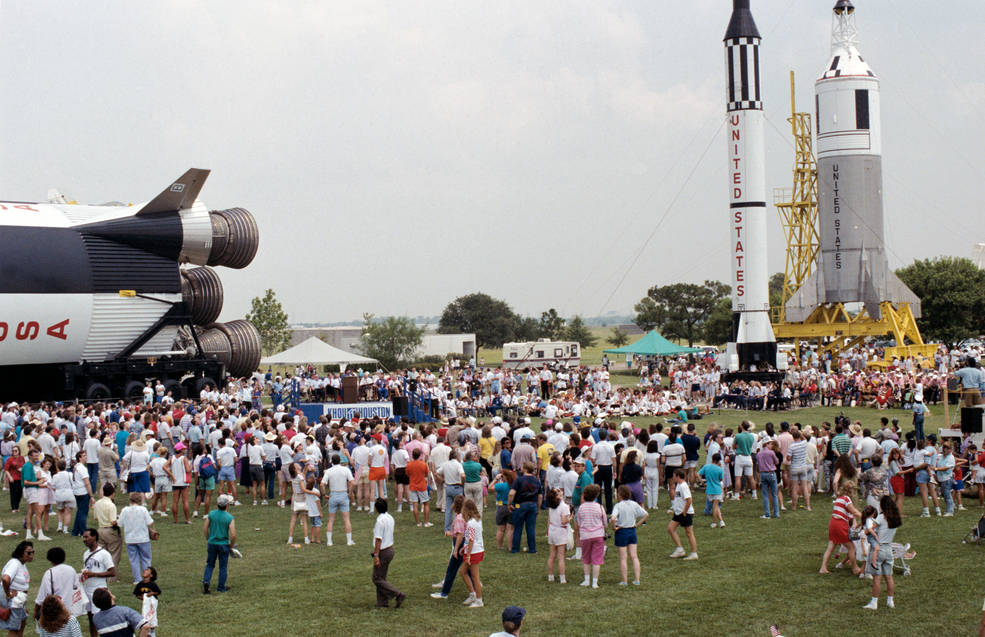
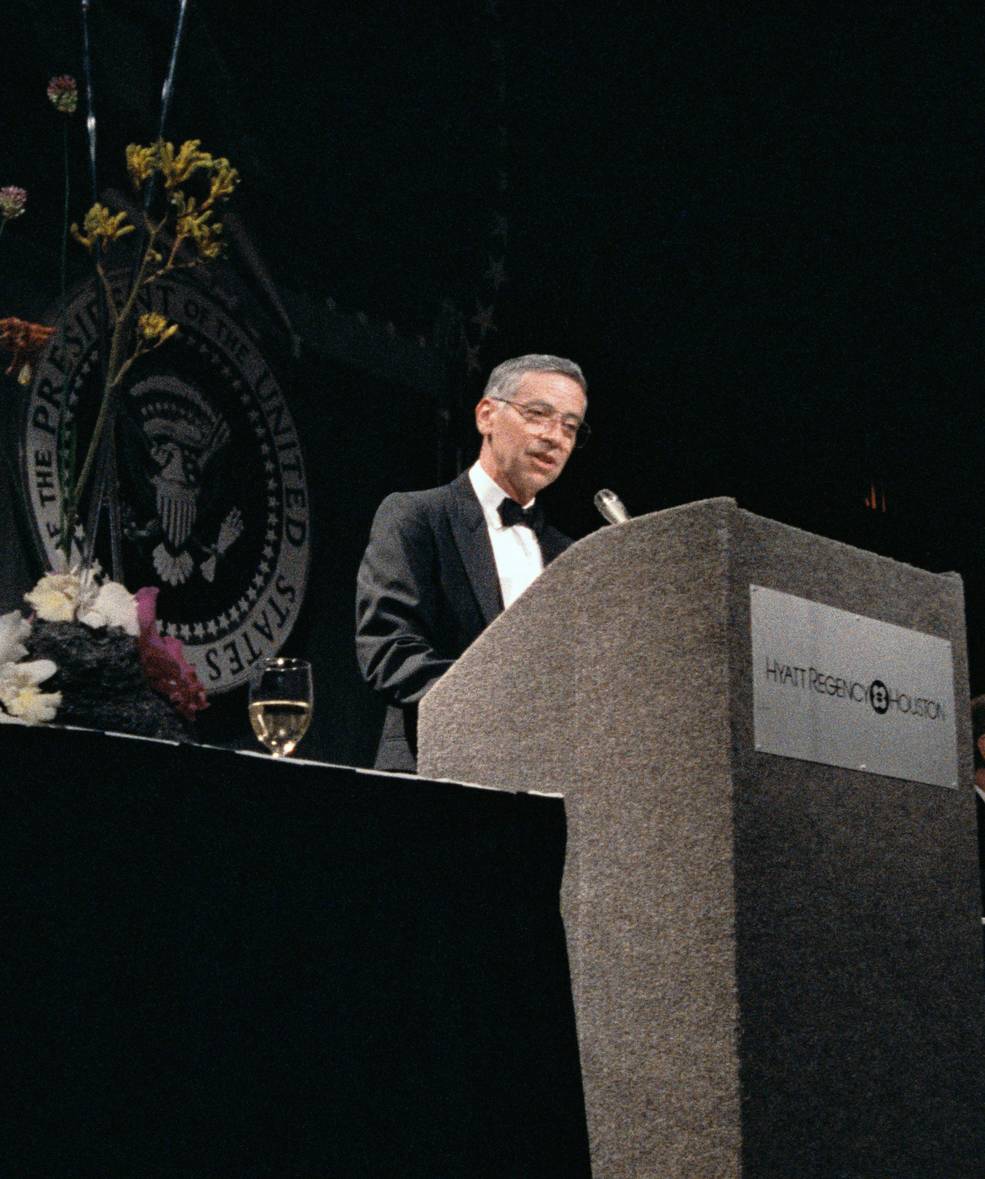
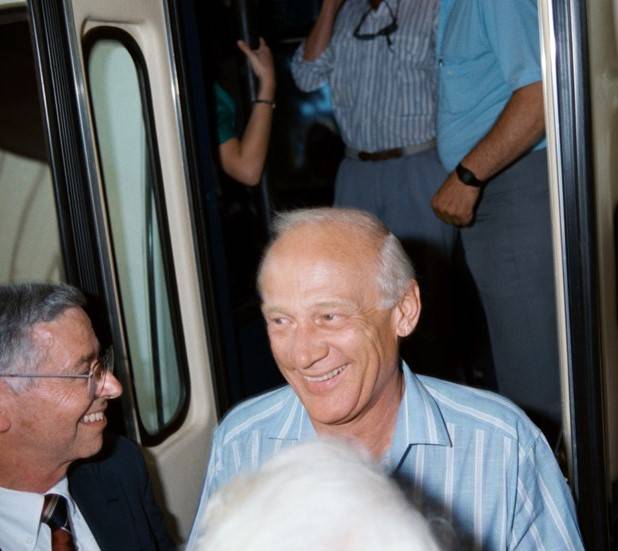
Left: Crowds gathered in July 1989 at Rocket Park at NASA’s Johnson Space Center (JSC) in Houston to celebrate the 20th anniversary of the Apollo 11 Moon landing mission. Middle: JSC Director Aaron Cohen speaking at the Apollo 11 20th anniversary event. Right: Cohen, left, with Apollo 11 astronaut Edwin E. “Buzz” Aldrin during the 20th anniversary celebrations.
In July 1989, JSC celebrated the 20th anniversary of the Apollo 11 Moon landing with events including a weeklong series of talks in the Teague Auditorium, a splashdown party at the Gilruth Recreation Center attended by 8,000 people, and a black-tie gala at the Hyatt Regency Hotel in downtown Houston. A weekend parade and rally at Rocket Park capped off the festivities. In anticipation of the celebration, the Lunar Landing Training Vehicle used by Apollo astronauts was returned from the Alabama Space and Rocket Center in Huntsville, Alabama, and placed on display in the lobby of Building 2, where it can still be viewed today. Leveraging on the Apollo 11 anniversary, President George H.W. Bush directed the agency to set its sights on a human trip to Mars via space station Freedom and a lunar outpost. NASA Administrator Richard H. Truly named Cohen to lead the agency’s response to the President’s call, placing him on a temporary detail to NASA Headquarters from July to November 1989. Deputy Director Weitz served as acting director in the interim. On Nov. 17, Cohen presented the Report of the 90-Day Study on Human Exploration of the Moon and Mars to the National Space Council chaired by Vice President J. Danforth “Dan” Quayle. A budget-conscious Congress balked at the price tag and the space exploration initiative did not materialize.
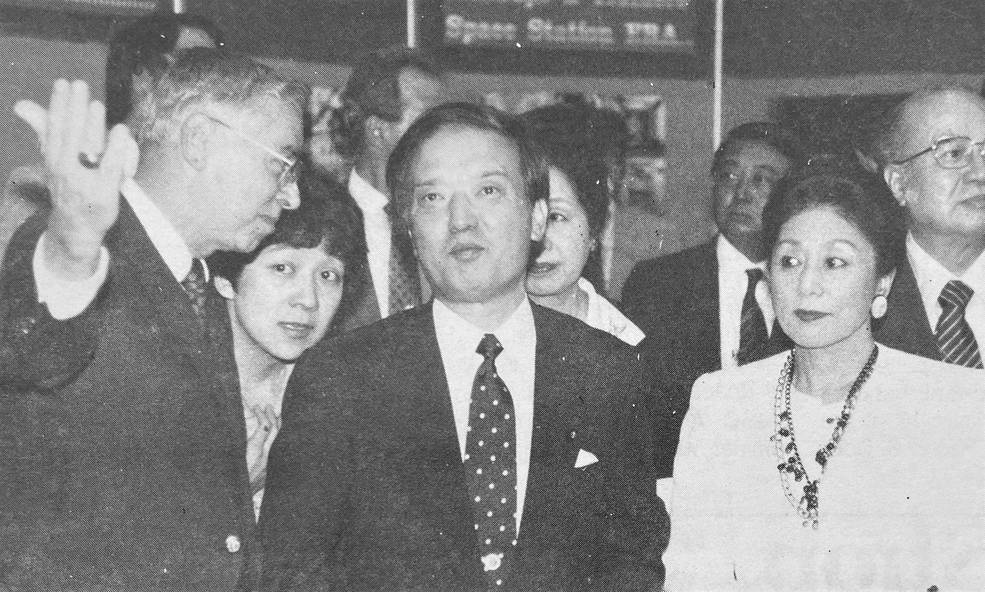
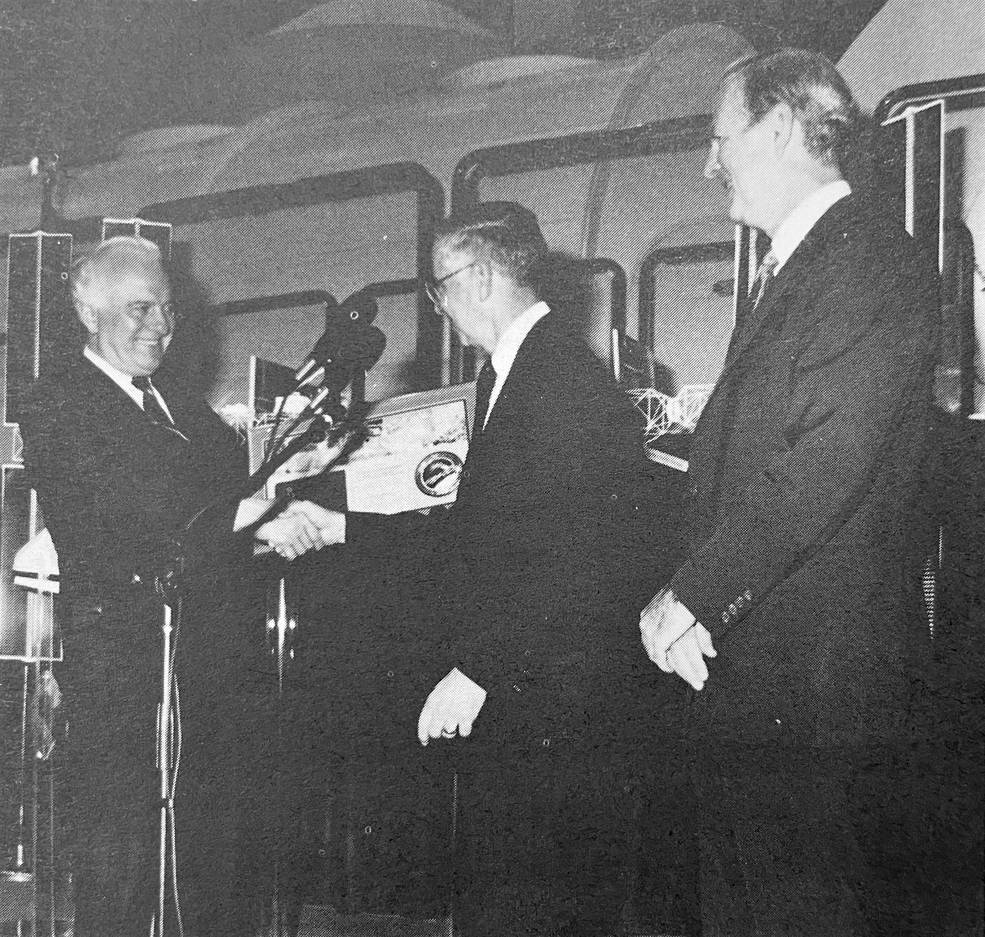
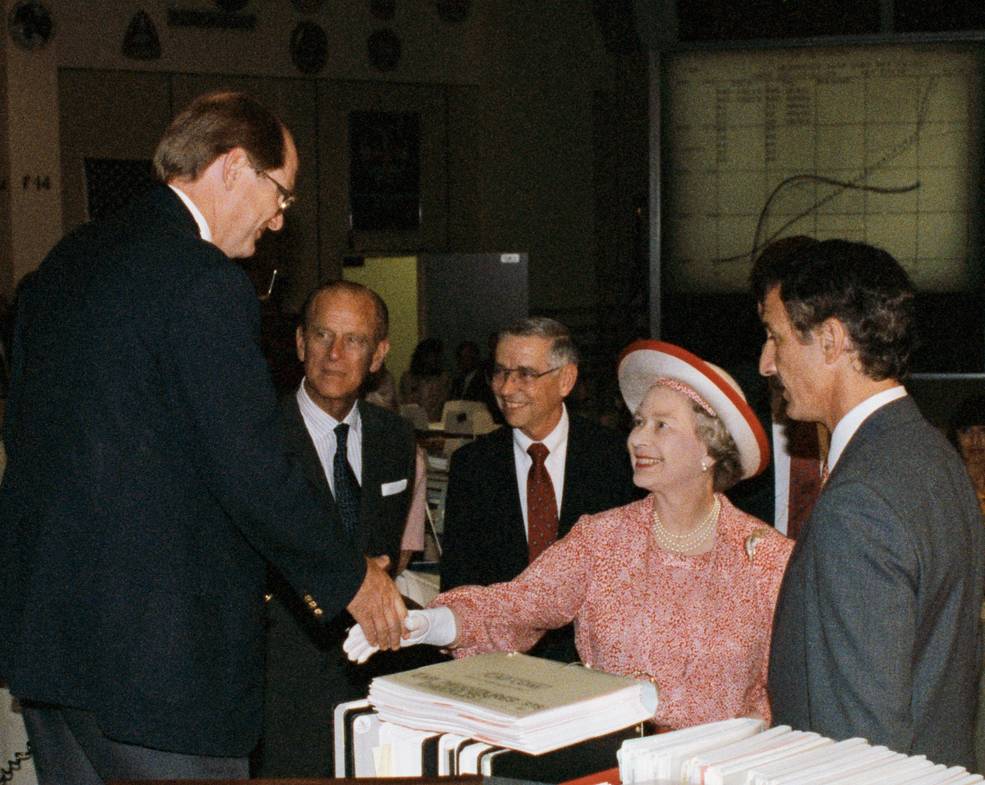
Left: Director of NASA’s Johnson Space Center (JSC) in Houston Aaron Cohen, left, escorts Japanese Prime Minister Toshiki Kaifu and his wife Sachiyo, in Houston for the July 1990 Economic Summit of Industrialized Nations, through Building 9B. Middle: In December 1990, Cohen, center, welcomes Soviet Foreign Minister Eduard A. Shevernadze, left, to JSC as U.S. Secretary of State James A. Baker looks on. Right: In May 1991, Cohen, center, tours Queen Elizabeth II of the United Kingdom, second from right, and her husband Prince Philip, second from left, through the Mission Control Center.
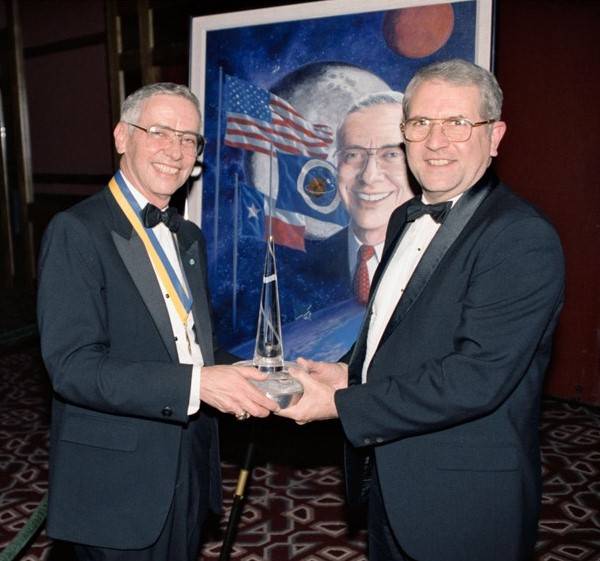
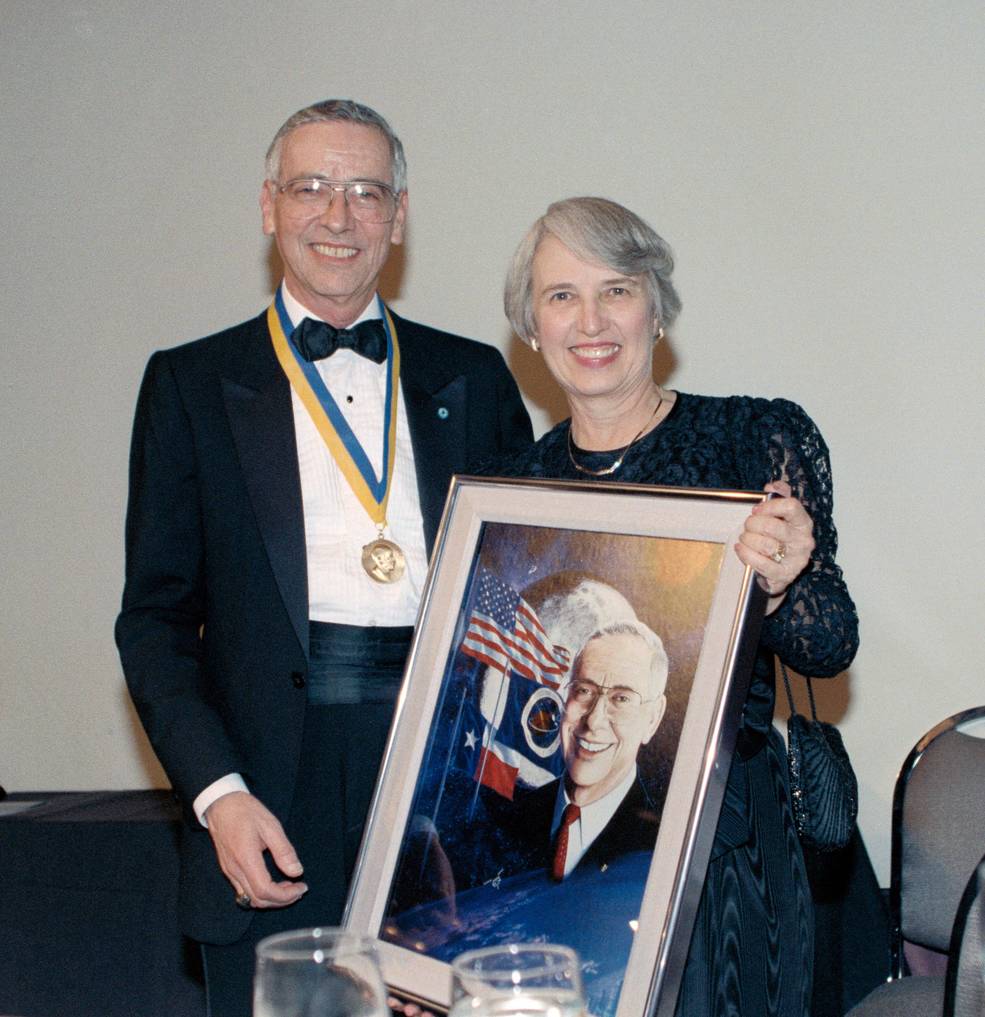
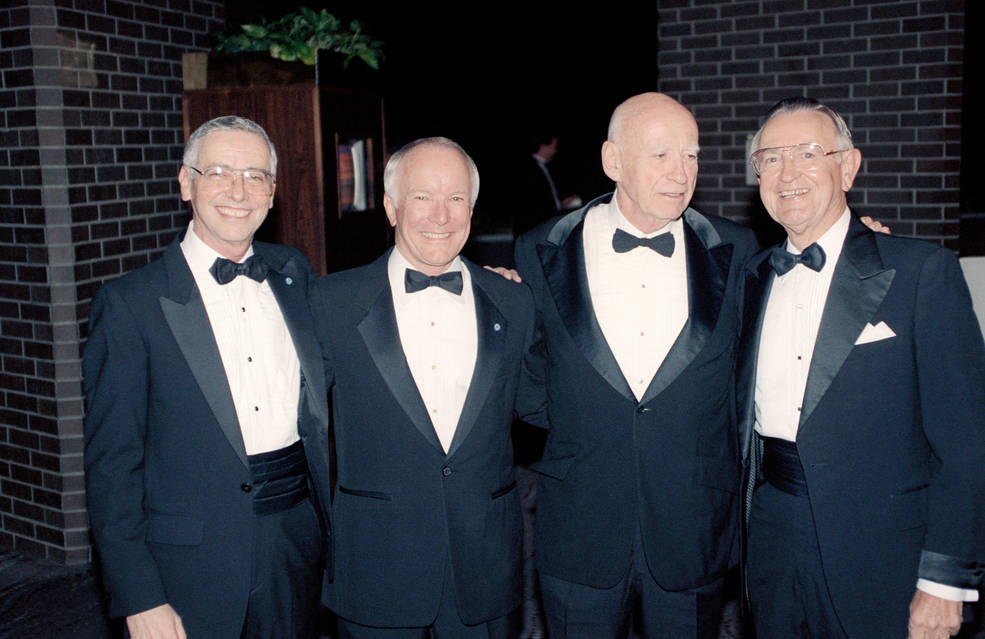
Left: NASA Administrator Richard H. Truly, right, congratulates Aaron Cohen, director of NASA’s Johnson Space Center in Houston, on receiving the 1991 Space Trophy from the Rotary National Award for Space Achievement Foundation. Middle: Cohen and his wife Ruth display the portrait painted for the occasion. Right: Four JSC directors at the February 1991 Rotary Awards ceremony – Aaron Cohen, left, Gerald D. Griffin, Robert R. Gilruth, and Christopher C. Kraft.
During his time as center director, Cohen received several prestigious awards in recognition of his outstanding contributions. In August 1988, President Reagan presented him with his second Distinguished Executive Rank Award, the highest presidential rank awarded to members of the Senior Executive Service. The following year, Cohen shared the Dr. Robert H. Goddard Memorial Trophy presented by the National Space Club for safely returning the shuttle to flight. He received the 1991 Space Trophy from the Rotary National Award for Space Achievement Foundation on Feb. 28, 1991, attended by NASA Administrator Truly and three previous JSC directors. Cohen was the 1993 winner of the American Institute of Aeronautics and Astronautics’ von Braun Award for Excellence in Space Program Management.
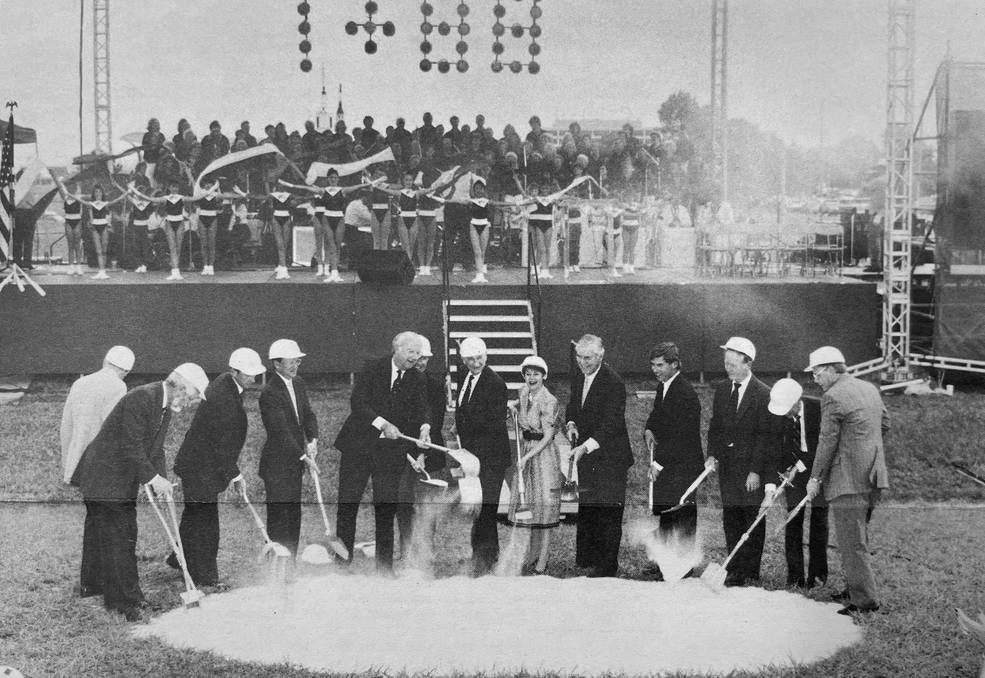
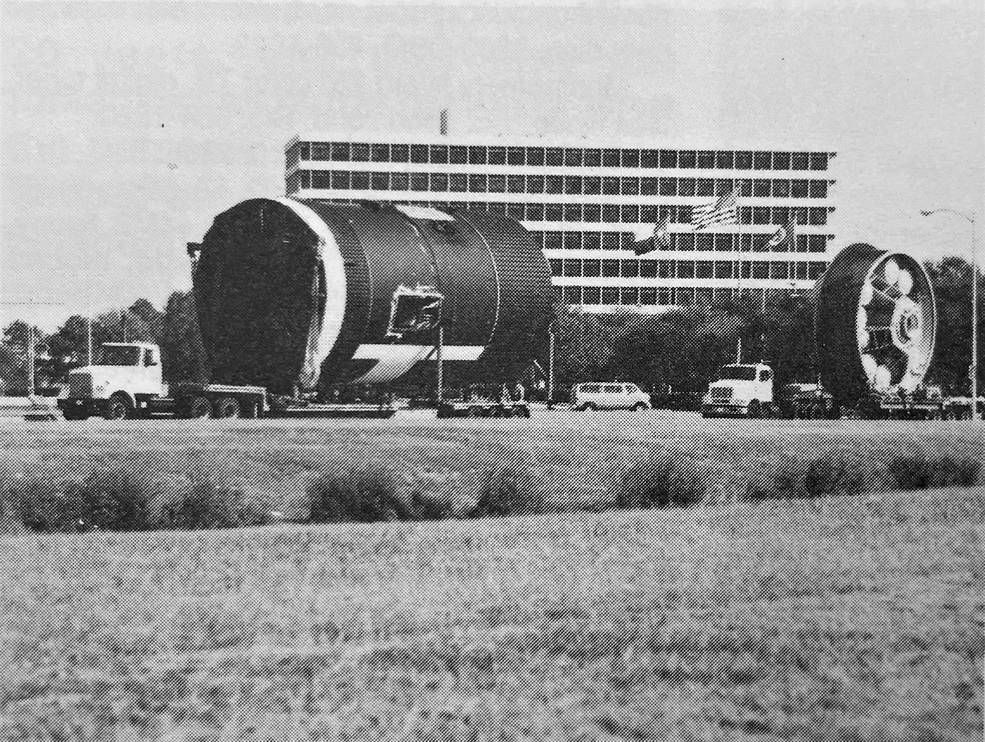
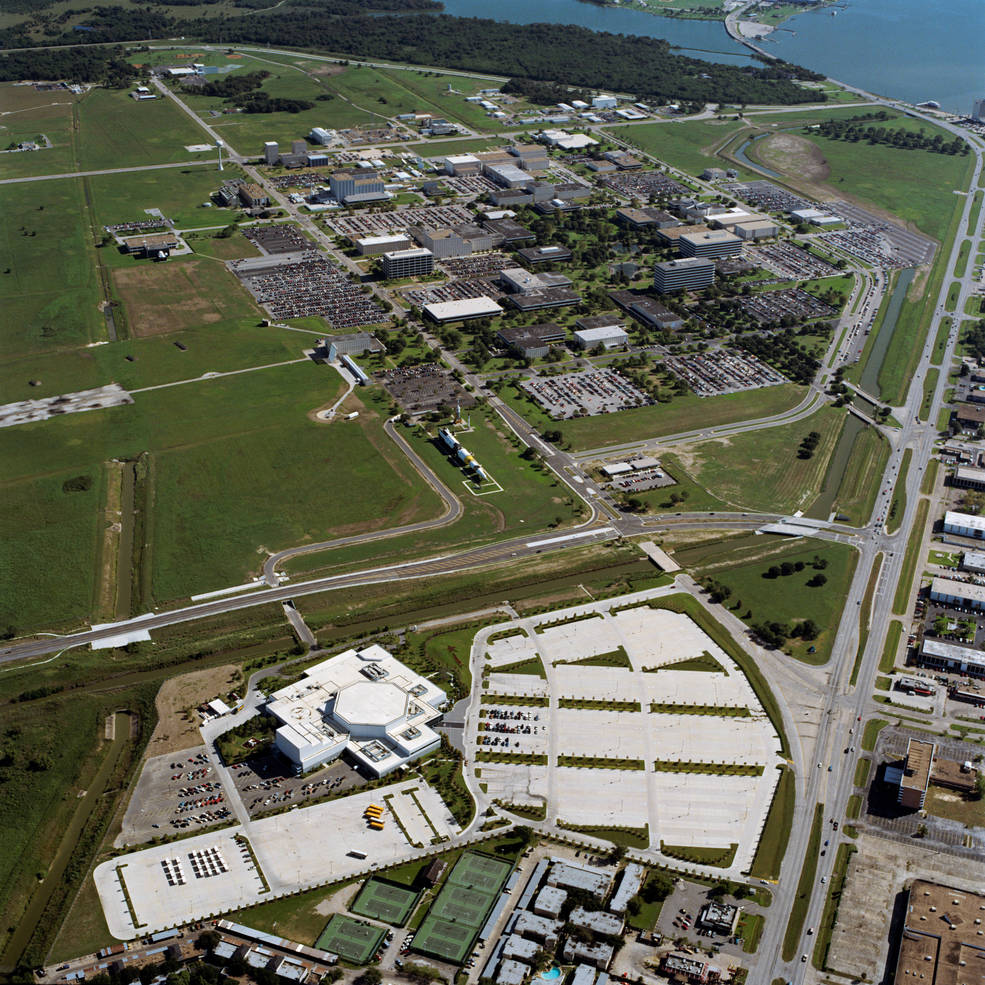
Left: Director of NASA’s Johnson Space Center (JSC) in Houston Aaron Cohen, second from right, at the groundbreaking for Space Center Houston in May 1991. Middle: Workers tow the Skylab trainer from JSC to Space Center Houston in November 1991. Right: Aerial view of JSC with Space Center Houston in the foreground.
With increasing numbers of visitors to JSC and an ever-growing number and size of artifacts to be displayed, the visitors center outgrew its available space in Building 2. In October 1986, JSC director Cohen signed a Memorandum of Understanding with the Manned Space Flight Education Foundation, Inc., to oversee development and construction of a new publicly accessible visitors center on 123 acres immediately adjacent to JSC’s main entrance. After several years of design by Walt Disney Imagineering and a fundraising campaign, Cohen, along with many dignitaries, attended the May 28, 1991 groundbreaking for Space Center Houston. Of the new visitors center, Cohen said, “The United States’ manned space program and the work of this center belong to the American people and it is important that they be able to learn about it and experience it firsthand. The facility we begin to construct today will provide that access.” The largest artifact to be put on display, the Skylab trainer, was brought in during construction and the rest of the building built around it. Rerouting of roads to accommodate public access to Space Center Houston and restricted JSC traffic and construction of a new security building were coordinated with the facility’s grand opening on Oct. 16, 1992.
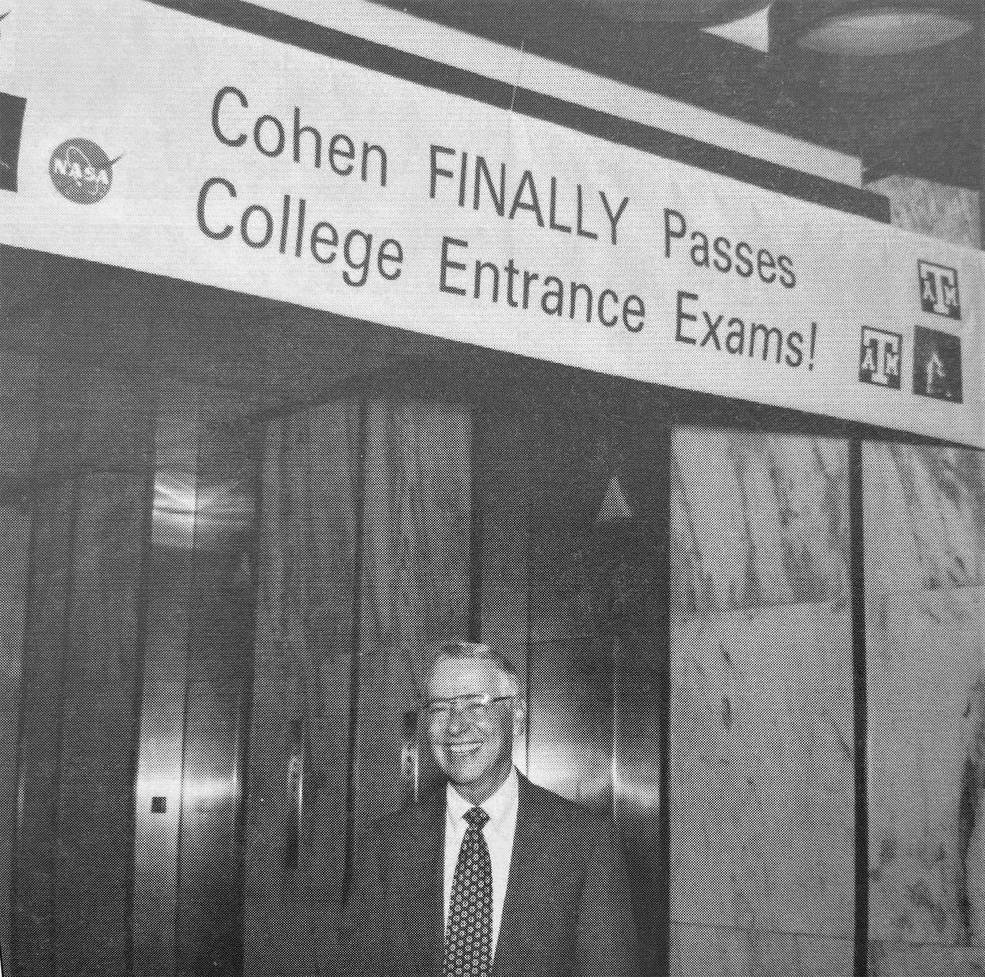
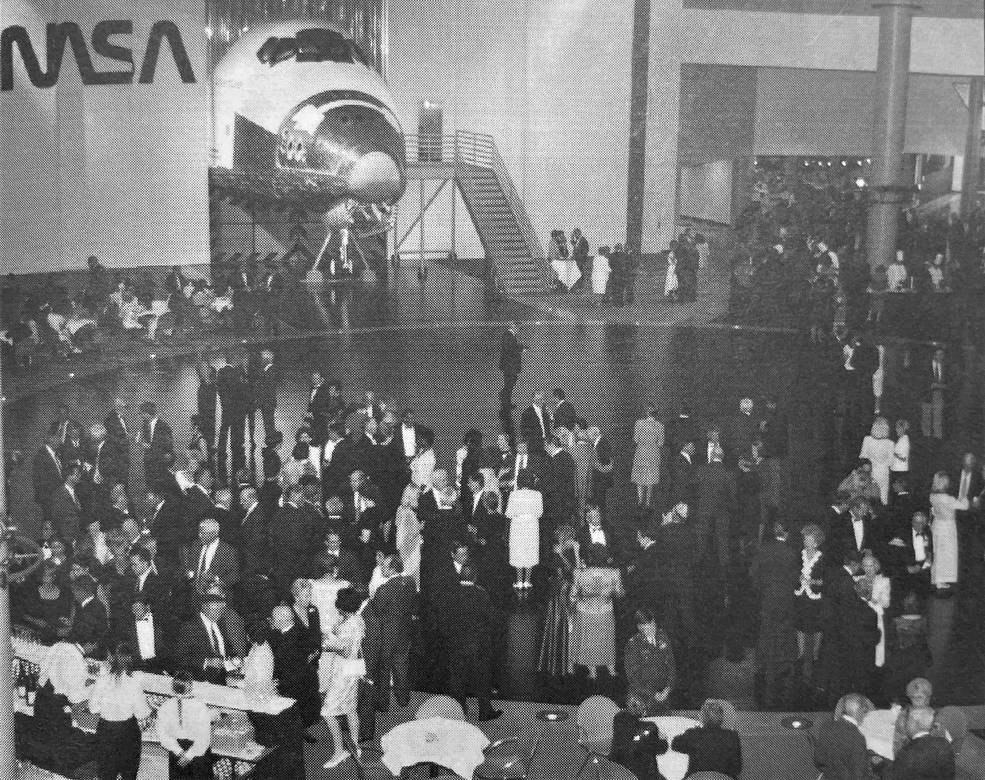
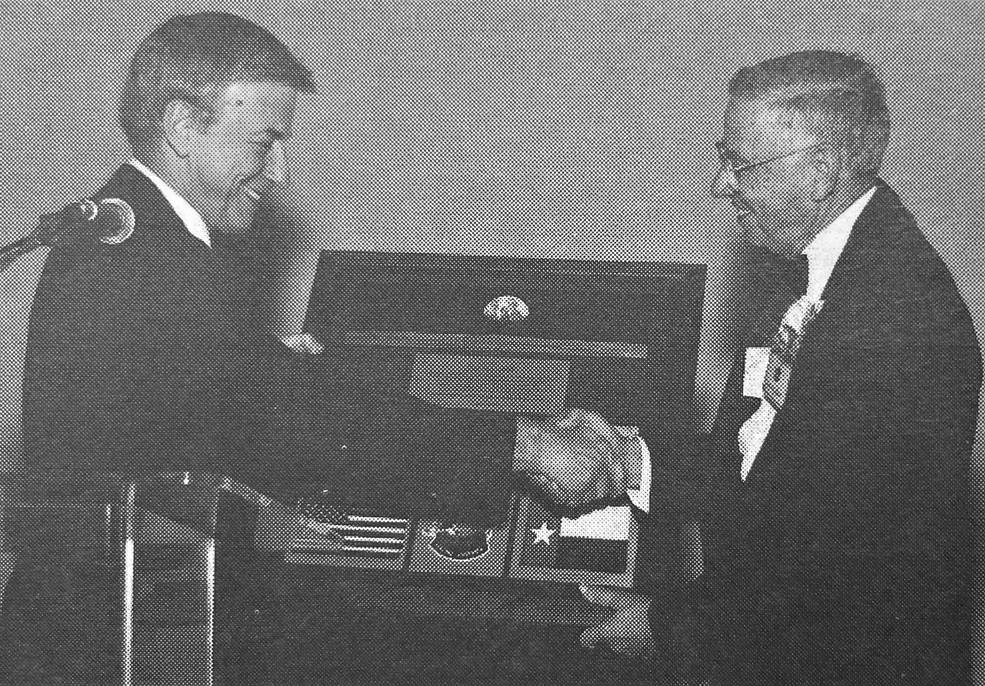
Left: On his last day as director of NASA’s Johnson Space Center (JSC) in Houston, Cohen’s staff designed a farewell sign humorously recognizing his future career in academia. Middle: Some of the 700 guests at Cohen’s farewell gala held at Space Center Houston. Right: Acting JSC Director Paul J. Weitz, left, presents Cohen with a plaque at his farewell gala.
In February 1992, NASA Administrator Truly named Cohen as acting NASA deputy administrator at NASA Headquarters, a position vacant since the previous November, to provide continuity as the agency transitioned from Truly to incoming administrator Daniel S. Goldin. Deputy Director Weitz again served as acting center director until Cohen’s return to JSC in December 1992. At a July 16, 1993 news conference with Administrator Goldin, Cohen announced his retirement, effective Aug. 20, to become the Zachry Professor of Engineering at Texas A&M University in College Station, Texas, ending his illustrious 33-year NASA career. Reflecting on that career, Cohen said, “I have had the privilege of working with the giants of our profession, and I have had the good fortune to see future giants in the making. I am confident our nation’s future space endeavors will be in good hands.” Deputy Director Weitz once again served as acting director until Goldin named Carolyn L. Huntoon as center director in January 1994. Cohen passed away on Feb. 25, 2010, at age 79. His widow Ruth attended the ceremony in 2011 that named the JSC Child Care Center after him.
The next installment in this series will cover JSC’s next two directors in the 1990s, including the center’s first woman director, up to the first missions of the International Space Station and into the new millennium.
John Uri
NASA Johnson Space Center



























